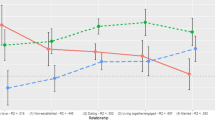Abstract
The purpose of this study, using an online methodology, was to investigate therapists' perceptions of the role of creativity in couples' and family therapy. Along with completing a quantitative measure assessing creativity in their work, participants responded to four open-ended questions which addressed the meaning of creativity, characteristics of a “creative” family therapist, some creative interventions they have used with couples and families, and barriers to their own creativity as a family therapist. A total of 142 marriage and family therapists in 36 states in the United States participated. The findings shed light on the unique importance of creativity in couples and family treatment.
Similar content being viewed by others
REFERENCES
Baer, J. (1993). Creativity and divergent thinking: A task-specific approach. Hillsdale, NJ: Lawrence Erlbaum.
Bernard, H. R. (2000). Social research methods: Qualitative and quantitative approaches. Thousand Oaks, CA: Sage Publications.
Carson, D. K. (1999a). The importance of creativity in family therapy: A preliminary consideration. The Family Journal: Counseling and Therapy for Couples and Families, 7, 326–334.
Carson, D.K. (1999b). Counseling. In M. Runco & S. Pritzker (Eds.), Encyclopedia of creativity (pp. 395–402). San Diego, CA: Academic Press.
Carson, D. K., & Becker, K. W. (in press). Creativity in psychotherapy: Reaching new heights with individuals, couples, and families. New York: Haworth Press.
Cole, H. P., & Sarnoff, D. (1980). Creativity and counseling. Personnel and Guidance Journal, 59, 140–146.
Csikszentmihalyi, M. (1996). Creativity: Flow and the psychology of discovery and invention. New York: Harper Collins.
Dacey, J., & Lennon, K. H. (1998). Understanding creativity. San Fransisco: Jossey-Bass.
Deacon, S.A.,& Thomas, V. (2000). Discovering creativity in family therapy: A theoretical analysis. Journal of Systemic Therapies, 19(3), 4–17.
Dowd, E.T. (1989). The self and creativity: Several constructs in search of theory. In J. Glover & C. Reynolds (Eds.), Handbook of creativity (pp. 233–242). NewYork: Plenum Press.
Frey, D.H. (1975). The anatomy of an idea: Creativity in counseling. Personnel and Guidance Journal, 54, 23–27.
Gladding, S.T., & Henderson, D.A. (2000). Creativity and family counseling: The SCAMPER model as a template for promoting creative process. The Family Journal: Counseling and Therapy for Couples and Families, 8, 245–249.
Heppner, P.P., Fitzgerald, K., & Jones, C.A. (1989). Examining counselors' creative processes in counseling. In J.A. Glover, R.R. Ronning, & C.R. Reynolds (Eds.), Handbook of creativity (pp. 271–280). New York: Plenum Press.
Innovations International (1998). Creativity Self Test. Salt Lake City, Utah.
Johnson, S.M., & Greenberg, L.S. (Eds.) (1994). The heart of the matter: Emotion in marital therapy. New York: Brunner/Mazel.
Kiser, D.J., & Piercy, F.P. (2001). Creativity and family therapy theory development: Lessons from the founders of solution-focused therapy. Journal of Family Psychotherapy, 12(3), 1–30.
Manning, P.K., & Cullum-Swan, B. (1994). Narrative, content, and semiotic analysis. In N.K. Denzin& Y.S. Lincoln (Eds.), Handbook of qualitative research (pp. 463–477). Thousand Oaks, CA: Sage Publications.
Miles, M.B., & Huberman, A.M. (1994). Qualitative data analysis (2nd ed.). Thousand Oaks, CA: Sage Publications.
Openlander, P. (1991). Creativity and systems therapy. Journal of Strategic and Systemic Therapies, 10(2), 69–83.
Papp, P. (1984). The creative leap: The links between clinical and artistic creativity. Family Therapy Networker, 8(5), 20–29.
Piercy, F., & Nelson, T. (1999, January/February). Flow in the consulting room. Family Therapy Networker, 23(1), 46–47.
Sternberg, R.J.,& Lubart, T.I. (1999). The concept of creativity: Prospects and paradigms. In R.J. Sternberg (Ed.), Handbook of creativity (pp. 3–15). New York: Cambridge University Press.
Taibbi, R. (1996). Doing family therapy: Craft and creativity in clinical practice. New York: Guilford Press.
Tesch, R. (1990). Qualitative data: Analysis types and software tools. New York: Falmer.
Weber, R.P. (1990). Basic content analysis (2nd ed.). (Quantitative Applications in the Social Sciences Series, Vol. 49). Newbury Park, CA: Sage Publications.
Wolcott, H.F. (1994). Transforming qualitative data: Description, analysis, interpretation. Thousand Oaks, CA: Sage Publications.
Author information
Authors and Affiliations
Rights and permissions
About this article
Cite this article
Carson, D.K., Becker, K.W., Vance, K.E. et al. The Role of Creativity in Marriage and Family Therapy Practice: A National Online Study. Contemporary Family Therapy 25, 89–109 (2003). https://doi.org/10.1023/A:1022562122420
Issue Date:
DOI: https://doi.org/10.1023/A:1022562122420



